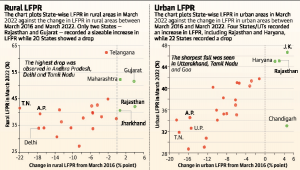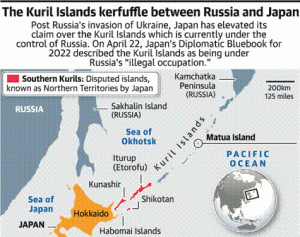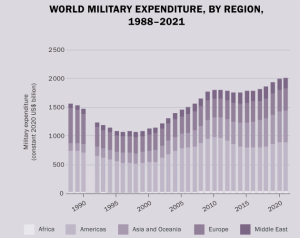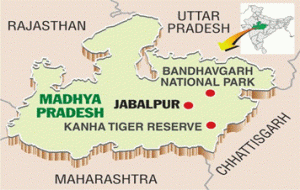THE GOVERNANCE AND SOCIAL ISSUES
1. OLD PENSION SCHEME VS NEW PENSION SCHEME
THE CONTEXT: Recently, Rajasthan and Chhattisgarh announced the restoration of the old pension scheme (OPS) for government employees for the year 2022-2023.
THE EXPLANATION:
NPS vs OPS: The old pension scheme was done away with in December 2003 by the BJP-led central government when Atal Bihari Vajpayee was prime minister. Its substitute, the National Pension Scheme (NPS), took effect from April 1, 2004.
| NEW PENSION SCHEME | OLD PENSION SCHEME |
|
In the NPS, the government and employees contribute an equal portion towards the pension fund. |
The old pension scheme was defined as opposed to the investment return-based NPS. |
|
The minimum payment to retired employees as pension is ₹3,500 in the NPS |
The old scheme provided 50% of the last drawn salary as the pension. |
| NPS provides a pension fund on retirement which is 60 per cent tax-free on redemption while the rest needs to be invested in annuity which is fully taxable. |
Income from OPS is not taxed. |
Pension Fund Regulatory and Development Authority:
- It is the statutory Authority established by an enactment of the Parliament, to regulate, promote and ensure orderly growth of the National Pension System (NPS).
- It works under the Department of Financial Services under the Ministry of Finance.
- It performs the function of appointing various intermediate agencies like Pension Fund Managers, Central Record Keeping Agency (CRA) etc.
- It develops, promotes and regulates the pension industry under the NPS and also administers the Atal Pension Yojana.
| PYQ-2017
Who among the following can join the National Pension System (NPS)? (a) Resident Indian citizens only (b) Persons of age from 21 to 55 only (c) All-State Government employees joining the services after the date of notification by the respective State Governments (d) All Central Governments Employees including those of Armed Forces joining the services on or after 1st April 2004 ANSWER: C |
2. ‘LABOUR PARTICIPATION DIPS TO 40% FROM 46% IN SIX YEARS’
THE CONTEXT: According to data from the Centre for Monitoring Indian Economy, Only 40% of Indians of legal working age were employed or were looking for jobs in 2021-22. In comparison, the labour force participation rate was above 46% in 2016-17.
THE EXPLANATION:
- In absolute terms, India’s labour force has shrunk from about 445 million to 435 million in the six years. Currently, about 1,085 million Indians are aged 15 or above and can be legally employed.

- Labour force participation among women, which was already in low double digits, has declined further. In 2016-17, about 15% women were employed or looking for jobs. This metric dipped to 9.2% in 2021-22.
- Among men, the participation rate declined to 67%, from more than 74%. The dip in the participation rate was higher in the urban areas.
- The rate slid to 37.5% from 44.7% in urban areas — a more than seven percentage-point drop. The rate in rural areas fell to 41.4% from 46.9%. Of the 24 States with data, 23 saw participation rates decline in March 2022 compared with March 2016.
- The rate dropped in all the States, except in Rajasthan. The slide was more pronounced in two southern States, which had a high participation rate to start with.
- Andhra Pradesh and Tamil Nadu had participation rates of 54% and 56%, respectively, in March 2016, and witnessed the sharpest declines. Between 2016 and 2022, participation rates fell 20 percentage points and 17 percentage points for Tamil Nadu and Andhra Pradesh respectively.

THE INTERNATIONAL RELATIONS
3. THE QUARREL OVER KURIL ISLANDS
THE CONTEXT: Recently, Japan’s Diplomatic Bluebook for 2022 described the Kuril Islands (which Japan calls the Northern Territories and Russia as the South Kurils) as being under Russia’s “illegal occupation”.
THE EXPLANATION:
This is the first time in about two decades that Japan has used this phrase to describe the dispute over the Kuril Islands. Japan had been using softer language since 2003, saying that the dispute over the islands was the greatest concern in Russia-Japan bilateral ties.
What are the Kuril Islands/ Northern Territories?
- These are a set of four islands situated between the Sea of Okhotsk and the Pacific Ocean near the north of Japan’s northernmost prefecture, Hokkaido. Both Moscow and Tokyo claim sovereignty over them though the islands have been under Russian control since the end of World War II.
- The Soviet Union had seized the islands at the end of World War II and by 1949 had expelled its Japanese residents. Tokyo claims that the disputed islands have been part of Japan since the early 19th century.

What lies behind the dispute?
- According to Tokyo, Japan’s sovereignty over the islands is confirmed by several treaties like the Shimoda Treaty of 1855, the 1875 Treaty for the exchange of Sakhalin for the Kuril Islands (Treaty of St. Petersburg), and the Portsmouth Treaty of 1905 signed after the Russo-Japanese war of 1904-05 which Japan had won.
- Russia, on the other hand, claims the Yalta Agreement (1945) and the Potsdam Declaration (1945) as proof of its sovereignty and argues that the San Francisco Treaty of 1951 is legal evidence that Japan had acknowledged Russian sovereignty over the islands. Under Article 2 of the treaty, Japan had “renounced all right, title and claim to the Kuril Islands.”
- However, Japan argues that the San Francisco Treaty cannot be used here as the Soviet Union never signed the peace treaty. Japan also refuses to concede that the four disputed islands were in fact part of the Kuril chain.
Have there been attempts at resolution?
- Since 1991, there have been many attempts to resolve the dispute and sign a peace treaty. The most recent attempt was under Prime Minister Shinzo Abe when joint economic development of the disputed islands was explored. In fact, both countries had agreed to have bilateral negotiations based on the 1956 Japan-Soviet Joint Declaration.
- Russia was even willing to give back two islands, the Shikotan Island and the Habomai islets, to Japan after the conclusion of a peace treaty as per the 1956 declaration.
- Japan’s attempt to improve ties with Russia was driven by its need to diversify energy sources and Russia by its need to diversify its basket of buyers and bring in foreign investments. But nationalist sentiments on both sides prevented resolution of the dispute.
What next?
- Soon after the Russian invasion of Ukraine, Japan made its unhappiness with Russia clear with its Foreign Minister Hideki Uyama, saying that Russia had “occupied” the southern part of the Kuril Islands, thereby violating international law.
- Japan has been among the most steadfast of Western allies in denouncing Russian aggression and punishing it with sanctions.
- The recent statement in its Diplomatic Bluebook will further damage relations between the two countries. Japan has probably been spurred by its fears of a Russia-China alliance as Japan itself has territorial disputes and an uneasy history with China.
- Secondly, Japan might have felt that this is a good opportunity to further isolate Russia and paint it as a “habitual offender” of international law.
- Finally, Tokyo might have been prompted to take this position as it feels that the invasion of Ukraine proves that getting back the Kuril Islands is a lost cause. Japan’s policy shift on the Kuril Islands will only embitter bilateral relations with Russia while advancing the possibility of its two neighbours, China and Russia, coming together against it.
THE ENVIRONMENT, ECOLOGY AND CLIMATE CHANGE
4. FOREST FIRES CAN BE AN IMPORTANT FACTOR IN REDUCING SOLAR POWER PRODUCTION IN INDIA
THE CONTEXT: A new study has found that forest fires which plague different parts of India, especially during the summer season play a major role in reducing solar power production in India.
THE EXPLANATION:
Analysis of the energy and financial losses due to the direct and indirect effects of forest fires on the production of solar plants can help grid operators to plan and schedule power generation, as also the distribution, supply, security, and overall stability of power production.
- Recently, solar energy generation has been widely used in developing countries such as India which has sufficient solar resources. However, several factors like clouds, aerosols, and pollution generated from various sources limit the solar irradiance causing performance issues in the photovoltaic and concentrated solar power plant installations. Large-scale development of a solar energy system requires proper planning, and there is a need to estimate the solar potential.
- Keeping this in mind, a group of researchers at the Aryabhatta Research Institute of Observational Sciences (ARIES), Nainital an autonomous research institute of the Department of Science and Technology (DST) Govt. of India, and the National Observatory of Athens (NOA), Greece tried to trace the factors that reduce solar energy production. They found that apart from clouds and aerosols, forest fires play a very crucial role in reducing solar energy production.
- The study published in the international peer-reviewed journal Remote Sensing shows that the aerosol optical depth values were up to 1.8 during the study period (January to April 2021), during which massive forest fire events led to attenuation of total solar radiation incident on a horizontal surface (global horizontal irradiance- GHI ) and solar radiation received from the sun without having been scattered (beam horizontal irradiance –BHI) by 0 to 45%. During this period the air masses were renewed quickly mitigating the smoke contribution to the total aerosol loads and were dominated by continental pollution.
- The scientists used remote sensing data for the research and studied the impact of aerosols and clouds on the solar energy potential over the Indian region with extensive analysis and model simulations. They also provided an analytical financial analysis in terms of revenue and losses due to clouds and aerosols.
- The findings of the present study will drastically increase the awareness among decision-makers about the effect of forest fires on energy management and planning at a country level. In addition, this research can support the mitigation processes and policies for climate change and its direct and indirect impacts on sustainable development.

Financial analysis of the aerosol, dust, and cloud impacts on the produced solar energy during January to April 2021. The impact was quantified in terms of daily mean and total energy losses, financial losses, and solar energy potential.
NEWS IN NUMBERS
5. ENABLING RURAL WOMEN
10 crores of women connected by Self-Help Groups (SHGs) who set the target of “Mission ₹1 lakh”, aimed at raising the annual income of women under self-help groups and boosting economic activity in rural areas across India. According to the Ministry for Rural Development and Panchayati Raj called upon the panchayats to ensure public welfare through empowerment, public participation, transparency and use of technology. Mission ₹1 lakh is an initiative aimed at enabling rural SHG women.
6. INCREASE IN INDIA’S MILITARY EXPENDITURE
- There is an 0.9 percentage, the increase in India’s military expenditure to $76.6 billion in 2021 when compared to 2020, according to a report released by defence think-tank Stockholm International Peace Research Institute (SIPRI).

- China, the world’s second-largest spender, allocated an estimated $293 billion to its military in 2021, an increase of 4.7%from 2020 and 72% from 2012, the report added. The militaries of India and China have been in a border standoff in eastern Ladakh for the last 23 months.
7. NATURAL FARMING
According to Agricultural Ministry, 4 lakh hectares, the land brought under natural farming so far as part of a sub-scheme of the Paramparagat Krishi Vikas Yojana, and it was the need of the hour to do farming that works in harmony with nature, reduces the cost of production, and ensures good-quality produce and profits to farmers. Noted that Andhra Pradesh, Himachal Pradesh, parts of Haryana and Gujarat were gradually adapting to natural farming.
| VALUE ADDITION
“Paramparagat Krishi Vikas Yojana” is an elaborated component of Soil Health Management (SHM) of major project National Mission of Sustainable Agriculture (NMSA). Under PKVY Organic farming is promoted through adoption of organic village by cluster approach and PGS certification. Expected outcomes The Scheme envisages: · Promotion of commercial organic production through certified organic farming. · The produce will be pesticide residue free and will contribute to improve the health of consumer. · It will raise farmer’s income and create potential market for traders. · It will motivate the farmers for natural resource mobilization for input production. |
8. TIGER DEATHS
The 17 tigers to have died in Madhya Pradesh in the last 107 days, including three due to poaching, according to an official. A tigress cub was found dead in the buffer zone of Bandhavgarh Reserve in what may have been the handiwork of an adult tiger. Between January and December 2021, the State had lost 42 tigers, the biggest chunk of the 127 deaths nationwide reported by the National Tiger Conservation Authority.
THE PRELIMS PRACTICE QUESTIONS
QUESTIONS OF THE DAY
Q1. In the field of economy, which of the following best explains meaning of term ‘cost disease’?
a) Increase in the cost of goods and services even if there is no increase in demand.
b) Selling of goods at low cost due to weak demand.
c) Increase in the cost of goods due to hoarding by traders.
d) Increase in the wages of certain laborer’s even though their productivity or skill level has not risen commensurately.
Q2. Kuril Islands, recently seen in news, are situated between
a) The Sea of Okhotsk and the Pacific Ocean
b)The Sea of Japan and the Pacific Ocean
c) The Sea of Okhotsk and the Sea of Japan
d) The Sea of Japan and the East China Sea
ANSWER FOR 25TH APRIL 2022
Answer: D
Explanation:
The National Statistical Office (NSO), Ministry of Statistics and Programme Implementation carries out an all-India survey on household consumption expenditure.
Spread the Word


